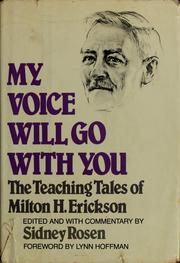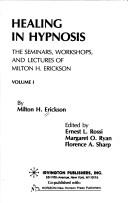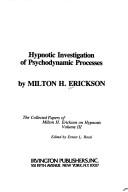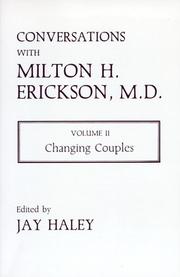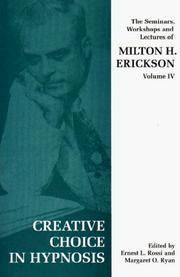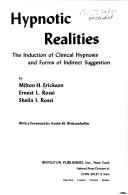Source: Wikipedia:
Milton Hyland Erickson (5 December 1901 – 25 March 1980) was an American psychiatrist and psychologist specializing in medical hypnosis and family therapy. He was founding president of the American Society for Clinical Hypnosis and a fellow of the American Psychiatric Association, the American Psychological Association, and the American Psychopathological Association. He is noted for his approach to the unconscious mind as creative and solution-generating. He is also noted for influencing brief therapy, strategic family therapy, family systems therapy, solution focused brief therapy, and neuro-linguistic programming.[1]
Hypnosis
Erickson is noted for his often unconventional approach to psychotherapy, as described in the book Uncommon Therapy by Jay Haley and the book Hypnotherapy: An Exploratory Casebook, by Milton H. Erickson and Ernest L. Rossi (1979, New York: Irvington Publishers, Inc.). He developed an extensive use of therapeutic metaphor and story as well as hypnosis and coined the term brief therapy for his method of addressing therapeutic change in relatively few sessions.
Beginning in the 1950s, Erickson's use of interventions influenced strategic therapy and family systems therapy of practitioners including Virginia Satir and Jay Haley. He was noted for his ability to "utilize" anything about a patient to help them change, including their beliefs, favorite words, cultural background, personal history, or even their neurotic habits.
Through conceptualizing the unconscious as highly separate from the conscious mind, with its own awareness, interests, responses, and learnings, he taught that the unconscious mind was creative, solution-generating, and often positive.
He was an important influence on neuro-linguistic programming (NLP), which was in part based upon his working methods.[1]
Trance and the unconscious mind
Erickson believed that the unconscious mind was always listening and that, whether or not the patient was in trance, suggestions could be made which would have a hypnotic influence, as long as those suggestions found resonance at the unconscious level. The patient could be aware of this or could be completely oblivious that something was happening. Erickson would see if the patient would respond to one or another kind of indirect suggestion and allow the unconscious mind to participate actively in the therapeutic process. In this way, what seemed like a normal conversation might induce a hypnotic trance, or a therapeutic change in the subject. According to Weitzenhoffer, "[Erickson's] conception of the unconscious is *definitely not the one held by Freud.*"[3]
Erickson was an irrepressible practical joker,[4] and it was not uncommon for him to slip indirect suggestions into all kinds of situations, including in his own books, papers, lectures and seminars.[5] For example, a student arrived at one of the five-day intensive seminars he held in his home office near the end of his life. When Erickson asked why she had come, she replied frankly: "My teacher told me that I should come to see you before you died." Erickson smiled and said: "You tell him that dying is the last thing I intend to do."[citation needed] The group laughed at the pun. Then Erickson said, with a twinkle in his eye[citation needed], "Do you want to know how to avoid dying? Always wake up every morning. And do you want to know how to ensure that you will wake up every morning?", he continued, "Drink lots of liquids before you go to sleep!"[citation needed]
Erickson also believed that it was even appropriate for the therapist to go into trance.
"I go into trances so that I will be more sensitive to the intonations and inflections of my patients' speech. And to enable me to hear better, see better."
Erickson maintained that trance is a common, everyday occurrence. For example, when waiting for buses and trains, reading or listening, or even being involved in strenuous physical exercise, it's quite normal to become immersed in the activity and go into a trance state, removed from any other irrelevant stimuli. These states are so common and familiar that most people do not consciously recognise them as hypnotic phenomena.
The same situation is in evidence in everyday life, however, whenever attention is fixated with a question or an experience of the amazing, the unusual, or anything that holds a person's interest. At such moments people experience the common everyday trance; they tend to gaze off to the right or left, depending upon which cerebral hemisphere is most dominant (Baleen, 1969) and get that faraway or blank look. Their eyes may actually close, their bodies tend to become immobile (a form of catalepsy), certain reflexes (e.g., swallowing, respiration, etc.) may be suppressed, and they seem momentarily oblivious to their surroundings until they have completed their inner search on the unconscious level for the new idea, response, or frames of reference that will restabilize their general reality orientation. We hypothesize that in everyday life consciousness is in a continual state of flux between the general reality orientation and the momentary microdynamics of trance ...[6]
Because Erickson expected trance states to occur naturally and frequently, he was prepared to exploit them therapeutically, even when the patient was not present with him in the consulting room. He also discovered many techniques for increasing the likelihood that a trance state would occur. He developed both verbal and non-verbal techniques and pioneered the idea that the common experiences of wonderment, engrossment and confusion are, in fact, just kinds of trance.
Clearly, there are a great many kinds of trance. Many people are familiar with the idea of a "deep" trance, and earlier in his career Erickson was a pioneer in researching the unique and remarkable phenomena that are associated with that state, spending many hours at a time with individual test subjects, deepening the trance.
That a trance may be "light" or "deep" suggests a one-dimensional continuum of trance depth, but Erickson would often work with multiple trances in the same patient, for example, suggesting that the hypnotised patient behave "as if awake", thereby blurring the line between the hypnotic and awake state.
Erickson believed there are multiple states that may be utilized. This resonates with Charles Tart's idea (put forward in the book Waking Up) that all states of consciousness are trances and that what we call "normal" waking consciousness is just a "consensus trance". NLP also makes central use of the idea of changing state, without it explicitly being a hypnotic phenomenon.
More at Wikipedia: https://en.wikipedia.org/wiki/Milton_H._Erickson
53 works Add another?
![]() Sorted by:
Most Editions
|
First Published
|
Most Recent
|
Top Rated
|
Reading Log
|
Random
Sorted by:
Most Editions
|
First Published
|
Most Recent
|
Top Rated
|
Reading Log
|
Random
Showing all works by author. Would you like to see only ebooks?
Subjects
Hypnotism, Therapeutic use, Psychotherapy, Hypnosis, Hypnose, Hypnothérapie, Hypnotism, therapeutic use, Erickson, milton h., 1901-1980, Psychiatry, Psychology, Subconscious Mind, Trance, Unconscious Mind, Communication, psychological aspects, Psychothérapie, Case studies, Counseling, Hypnothâerapie, Mental suggestion, Methods, Psychotherapie, Psychotherapists, Allied Health Services - Hypnotherapy, Attitude, Attitude changePeople
Milton H. EricksonID Numbers
- OLID: OL953652A
Links (outside Open Library)
No links yet. Add one?
| May 4, 2020 | Edited by Ultra_Being | Edited without comment. |
| August 22, 2008 | Edited by RenameBot | fix author name |
| April 1, 2008 | Created by an anonymous user | initial import |


